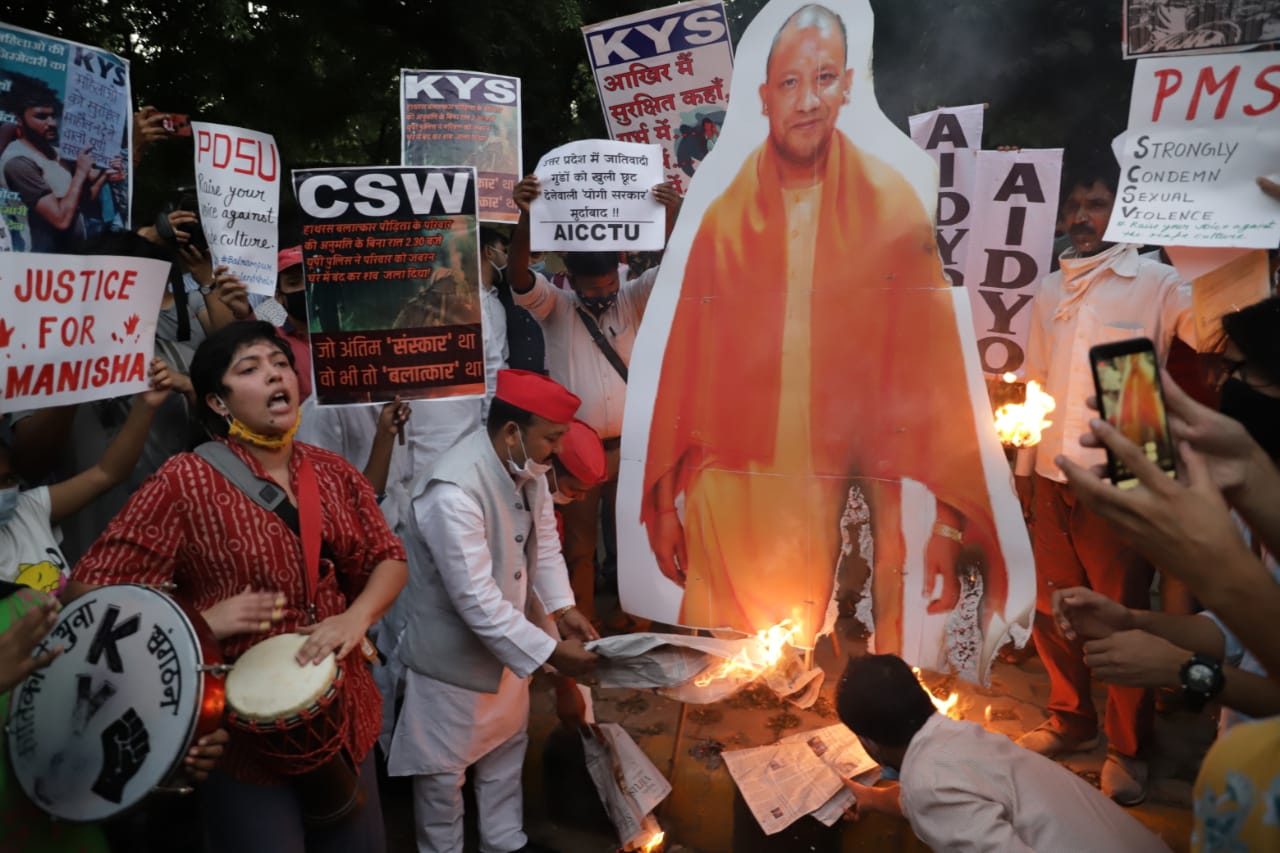Hathras: Protestors burn Yogi Adityanath’s effigy in Delhi

Protesters burning Yogi Aditnath's effigy during Hathras protests at Jantar Mantar on Monday (MIG Photos/Aman Kanojiya)
Three days after a massive protest at Jantar Mantar in New Delhi, demanding the resignation of UP chief minister Yogi Adityanath, another protest took place on the same spot as civil society activists, student organisations, woman organisations and concerned citizens gathered to continue the protest. The activists, led by All India Student Association (AISA), a students’ organisation, also burnt Adityanath’s effigy. They also chanted slogans against him and his misrule in the country’s most populous state. The demonstrators said they would continue the movement until their central demand of Adityanath’s resignation was met.
The protestors said that ever since Adityanath took charge after the last assembly elections in 2017, there has been a spurt in violence against women, minorities as well as the Dalits.
Their claims were backed by the data published by the National Crime Record Bureau (NCRB) according to which India reported 4,05,861 cases of crimes against women in 2019 and Uttar Pradesh topped the list with 59,853 incidents. Out of the total reported rape cases in the country last year, 11 pcvictims were from Dalits, as per NCRB’s annual report titled Crimes in India 2019, released on October 5.Uttar Pradesh also had the highest number of crimes against girl children under the POCSO Act with 7,444 cases.
National executive member of AISA, Madhurima Kundu, who was leading the protest at Jantar Mantar on Monday, spoke with Media India Group about the protest’s aim, reach and demands.
What are your demands?
We demand the resignation of UP CM Ajay Bisht or Yogi Adityanath. Caste-based violence and caste atrocities have increased by leaps and bounce since he has come to power. One out of every four caste-based atrocities in India happen in UP. There has been a 40 pc increase in caste-based violence under the Yogi government in UP. The recent Hathras rape case is gender-based violence as well as violence committed against Dalit caste. Even during the Covid19 lockdown, there have been numerous incidents of crimes, violence and atrocity against Dalits by the Thakur (an upper caste community in India) community, to which Ajay Bisht belongs. Hence, it is our central demand.
Do you see or expect to see these protests reaching its aim?
Historically, students’ protests have brought down governments and we are committed to sustaining our protest until our demands are fulfilled. The issues of gender and caste in India are integrated. Under the current government, violence is amplified. In this incident and similar incidents before this, we have seen that the government has been protecting the rapists instead of the victim. We have not witnessed anything like this before that the entire machinery of police and judiciary trying to protect the culprits. We have seen the government protecting KuldeepSengar in Unnao rape case, in Kathuacase, we have seen the BJP rallying in support of the culprits.
Even the special task force formed after the Hathras case consisted of people from Thakur community. It was almost a special ‘Thakur force’ to justify the violence or to exonerate the people involved in the violence.
Apart from Delhi, where are you protesting and who all are part of the protest?
Our protests are happening across the country. Members of our organisation have been protesting in Lucknow, Varanasi, Kolkata, Assam, Rajasthan and many other states. Delhi, as it is the national capital, remains the centre of all protests.
Different student organisations like All India Student Federation (AISF), KYS (KrantikariYuvaSangathan), many women organisations, trade unions, members of different political parties and people from the civil society are participating in the protest. It becomes important for people of all sections to come together as it is the need of the hour to speak against the violence and the government perpetuating it. Even in the recent Babri Mosque demolition case, the verdict seems biased and we do not have trust in the judiciary anymore. The judiciary has become a puppet in the hands of the government.
What do you have to say about the status of media during these times?
There have been local journalists and small, local media houses that have worked and helped to make the Hathras case a national issue. But unfortunately, the bigger media houses and the journalists that are a household name have not been doing their work. The mainstream media undoubtedly has become a puppet of the government.
It is so painful to witness that almost all the fundamental pillars of democracy from the judiciary to media and even the executives like a district magistrate have been corrupted and become a mere puppet. In the Hathras incident, burning the corpse of the victim at midnight, without the permission of her family cannot have happened without the executives like district magistrate being involved.
In the absence of media showing what you are protesting for, how is this going to sustain and reach those who need to hear?
It has been absolutely difficult to raise our voice in the absence of media coverage. But on the brighter side, since last few years, there has been a rise in an alternative media. There are a lot of local journalists, smaller media outlets, digital media and the ones present on YouTube and different social media sites who have highlighted the problems and are listening and bringing demands in the eyes of the public and the government. On a personal level, we are also trying to reach people through various social media platforms.
What has been the impact and reach of these protests?
Apart from Jantar Mantar in Delhi, which has been the centre of our protest, we are also doing candle marches and rallies in different parts of Delhi and other states in the country. Many people from different sectors and general citizens have joined our agitation. We have seen a good number of citizens coming out on roads for this cause. Just a couple of days back, we organised a march in BudhhVihar in Delhi, located opposite Jawaharlal Nehru University (JNU) and we are determined to continue our protest, however small it may be.
Since the anti-CAA protests in Delhi, we have seen a lot more people joining our protest for different causes, especially against the violence and injustice committed towards the victim and her family in this case.
There is no doubt that our path is full of struggles and is we have a very long way forward, but thousands of people have joined us and that inspires us to continue our fight against the systematic oppression and speak up whenever needed. We face a lot of hurdles but at the same time, we also hope to make a difference gradually.










